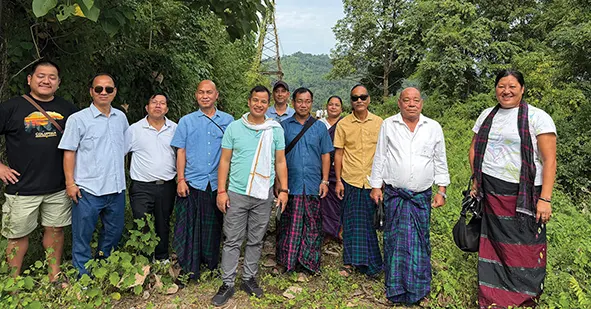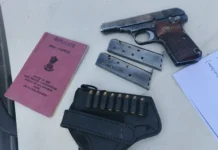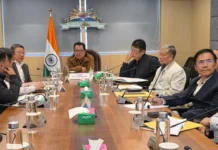[ Pisi Zauing ]
MIAO, 29 Oct: Beneath the gentle whispers of the Noa Dehing river, hope has begun to rise once more. The long cherished dream of a motorable bridge connecting Miao with N’khumsang on the right bank has finally taken its first concrete step toward reality.
On 28 October, officers from the public works department guided by the Tumken Lollen (EE, PWD), Lijum Geyi (AE, Miao), W.W. Ronrang (AE, Deban) and Kenmar Basar (JE, Deban) – joined hands with local Singpho leaders to earmark two potential sites: one at the tranquil Ropeway Point and another slightly downstream, where the bridge may soon stand tall.
For decades, the people of Miao and N’khumsang have gazed across the wide waters, their hearts yearning for a link that could bind them in both spirit and progress.
In the absence of a bridge, villagers were forced to rely on fragile, accident prone country boats to cross the river. In several tragic mishaps over the years, many precious lives were surrendered to the jaws of death – a haunting reminder of how vital this long awaited bridge truly is.
The Singpho people of the N’khumsang area were the ones to donate land to the government and played a vital role in establishing the Miao administrative circle and various government departments during the 1950s. Yet, despite their immense contribution, successive elected representatives of Miao and successive state governments took them for granted. Their repeated pleas for a motorable bridge across Noa Dehing fell on deaf ears for decades.
In 2009, during the Namdapha Eco-Cultural Festival held on the riverbed at Miao, the then Chief Minister Dorjee Khandu – who graced the occasion as Chief Guest – had assured the people of a bridge. But his untimely demise soon after shattered the dream of the Singphos of N’khumsang. Today, thanks to Chief Minister Pema Khandu for keeping alive his late father’s promise and announcing the bridge during the Cabinet Aapke Dwar held at Miao on 7-8 October, that unfulfilled dream has finally been revived.
Among those who walked the earmarked sites were Singpho leaders Pisi Gam Singpho, Thuing Pisi, Gumjanong Singpho, Jowong Tingwa, Pisi Zauing, Pisi Zaugawng, Ongko Pisi and Phupla Singpho among others. Their presence was more than ceremonial – it was an affirmation that change, long deferred, is finally on its way.
The absence of a bridge had long kept the right bank secluded, untouched by the pulse of modern development. Yet the Singpho people of N’khumsang have remained steadfast – their loyalty unwavering, their faith unbroken. With the government’s renewed commitment, a long tunnel of waiting finally shows light at its end.
When the bridge rises over the Noa Dehing, it will carry far more than vehicles. It will carry aspirations, trade, ideas, and dreams. Lands once silent will awaken to the hum of enterprise; schools, homes, and small industries will take root beneath the watchful skies of Arunachal Pradesh. The youth will find purpose, and progress will flow with the river’s song.
Former MLA and N’khumsang chief K.G. Singpho expressed heartfelt gratitude to the Chief Minister Pema Khandu for the initiative, urging quality workmanship and timely completion. Gamseng Singpho, president of Miao Singpho Ramma Hpung, envisioned the bridge as a gateway to tourism, hospitality, and a new era of prosperity.
For the people of the right bank, this bridge will be more than concrete and steel – it will be a bridge of belonging, a bridge of hope, and above all, a bridge that unites hearts long separated by the silent sweep of a river.




